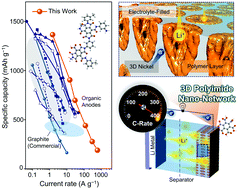3D periodic polyimide nano-networks for ultrahigh-rate and sustainable energy storage†
Abstract
Organic molecules with redox-active motifs have attracted great attention as next-generation electrodes for sustainable energy storage. While there has been significant progress in designing redox-active molecules, the practical requirements of high electrochemical activity and stability, as well as rapid kinetics for fast charging, are motivating a search for methods to engineer three-dimensional (3D) structures of organic-based electrodes. Here, we demonstrate a lithographic fabrication strategy for realizing a 3D bicontinuous nano-network consisting of a periodically porous nickel-supported redox-active polyimide layer (pore radius <300 nm), which provides highly conductive pathways for electron and ion transport. Through super-lithiation of nearly all unsaturated C![[double bond, length as m-dash]](https://www.rsc.org/images/entities/char_e001.gif) C bonds in this 3D-structured anode, a high reversible capacity of 1260 mA h g−1 and 82.8% capacity retention over 250 cycles at a 10C rate are realized. Rates of up to 400C for lithium-ion storage of organic anodes have been achieved for the first time, opening up new engineering opportunities for high-performance organic batteries.
C bonds in this 3D-structured anode, a high reversible capacity of 1260 mA h g−1 and 82.8% capacity retention over 250 cycles at a 10C rate are realized. Rates of up to 400C for lithium-ion storage of organic anodes have been achieved for the first time, opening up new engineering opportunities for high-performance organic batteries.



 Please wait while we load your content...
Please wait while we load your content...